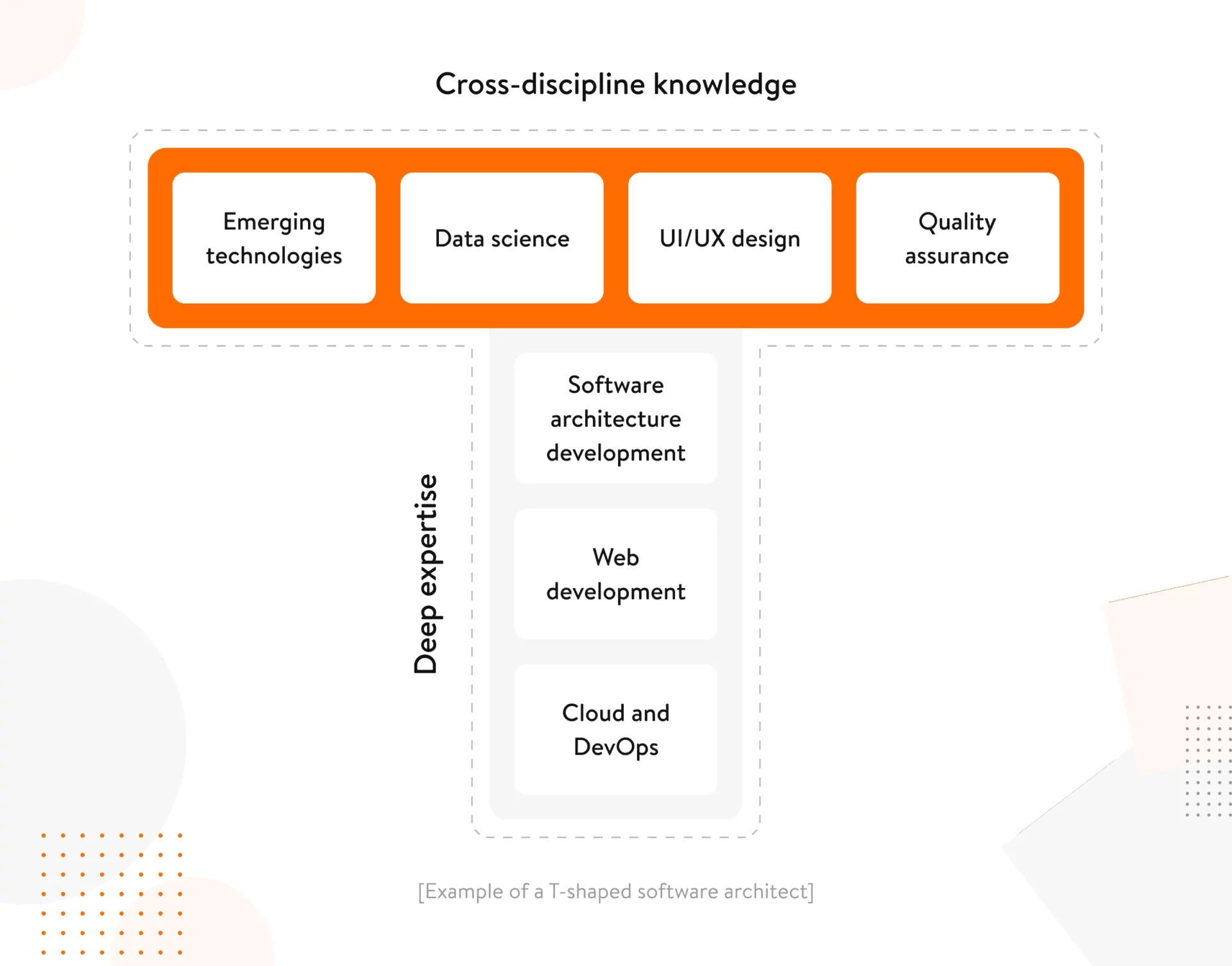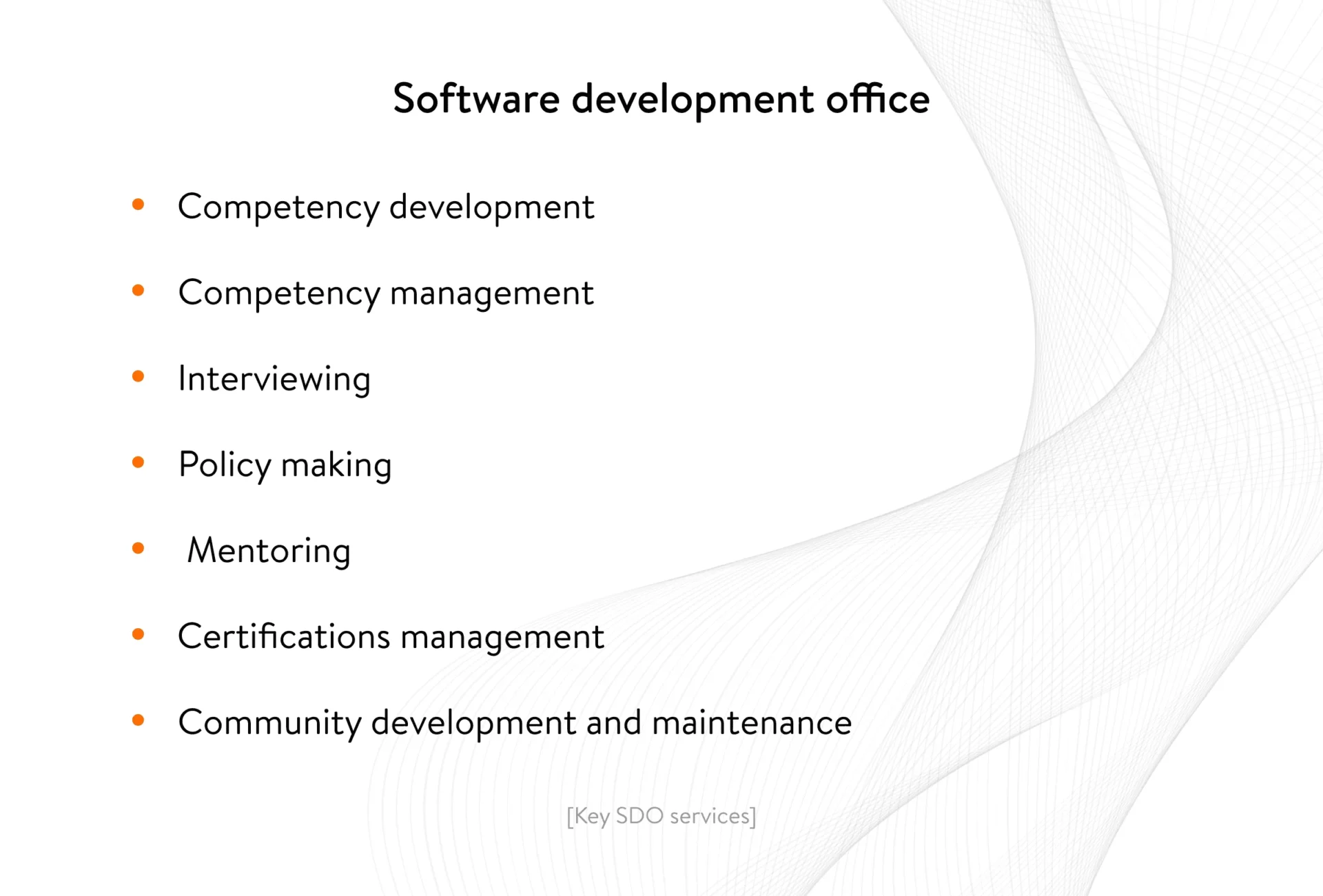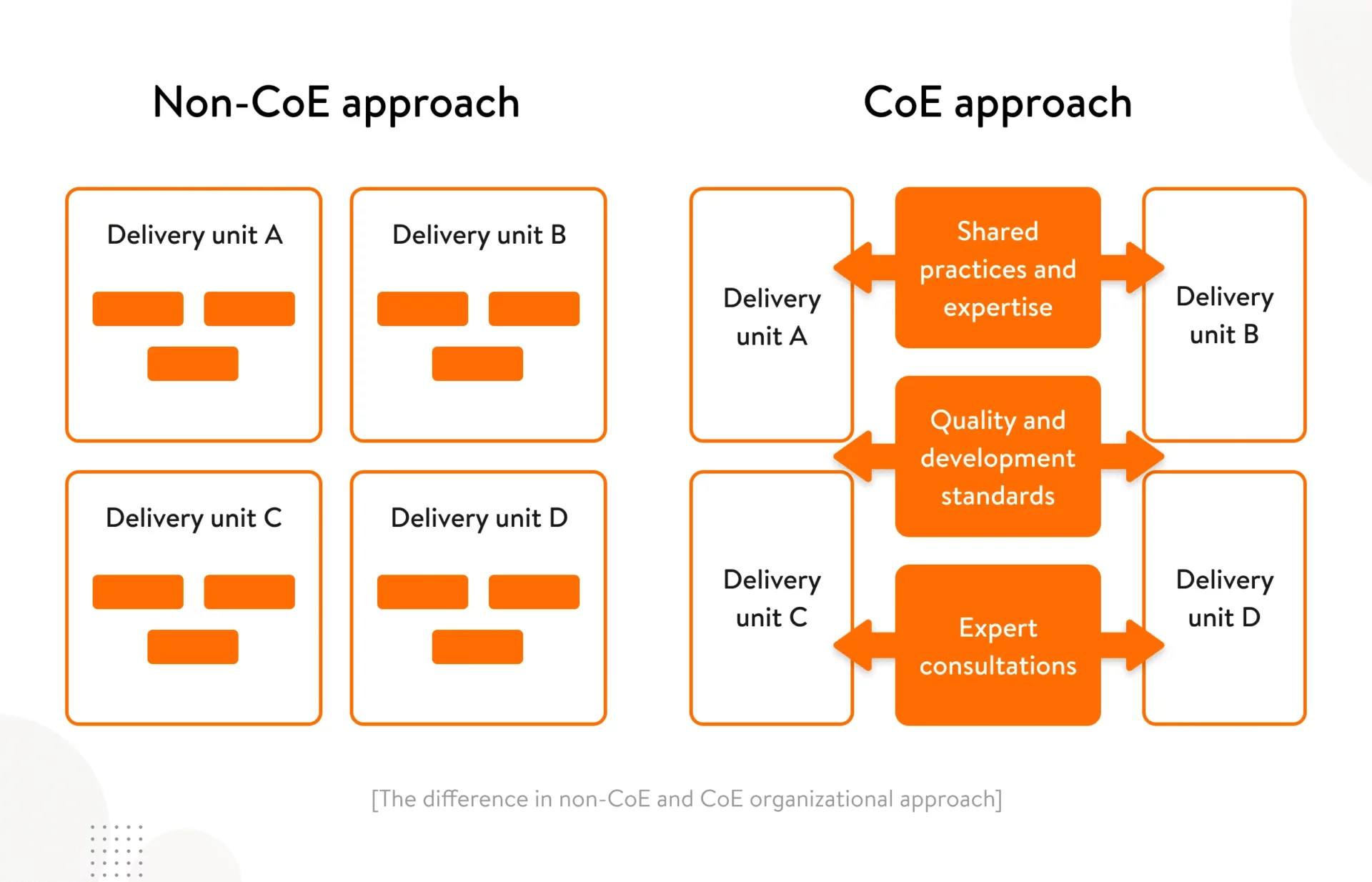
Software partner with Centers of Excellence and a Software Development Office
Summarize:
Businesses often spend much time looking for software partners with a specific technology or domain expertise. But as a project evolves, the necessity for additional expertise may arise. When that happens, if your current software development company can’t provide extra support and additional technical expertise, your project may get stuck. To ensure an uninterrupted project development process, mature and trusted IT service companies establish Centers of Excellence (CoEs) and a Software Development Office (SDO).
Role of CoEs and an SDO in a software development company
The existence of CoEs and an SDO means that a technology company has reached a high level of maturity and can guarantee that its clients get top-quality services.
A CoE is a group of experts in a certain technology, domain, or skill within a software development company. An SDO is an organizational division in the company that primarily takes charge of software developers’ performance and improvement and provides support to developers. There can be many CoEs but only one SDO in a software organization.
In this article, we’ll probe the services and solutions CoEs and SDOs provide in the outsourcing software development industry. Centers of Excellence and a Software Development Office guard your project’s success by:
- ensuring that only competent and skilled professionals work on your projects
- dealing with unexpected issues and disruptions in project delivery
- providing for ongoing development of specific technical expertise
Why do businesses choose IT partners with CoEs and an SDO?
High technical competence of software vendors is essential, as the technology market is expanding and the business need for disruptive technologies is rapidly growing. SWZD expects that 50 percent of business workflows will run in the cloud by 2023, up from 40 percent in 2021. In line with that, cloud investments are projected to increase by a statistically critical four percent of their current volumes, from 22 percent in 2020 to 26 percent in 2022.
Even though there are many ready-made software solutions on the market, they mostly cover common issues and needs. Clients who need to solve business-specific and non-typical challenges seek out companies with deep technical expertise.
Plus, proficient software vendors not only hone existing skills on their current projects but also invest time, money, and effort into the constant development of their employees. CoEs and the SDO aim to establish and support a well-organized process of employee evolution within the software company.
Thus, to smoothly shift from on-premises to the cloud, undergo a successful digital transformation, or implement any advanced technologies (e.g. big data analytics), you should cooperate with a mature software development vendor. Take a look at our extensive expertise at Yalantis as well as a center of excellence we’ve established for cloud and DevOps to provide you with expert and up-to-date services.
Let’s get a closer look at a CoE and an SDO to figure out how your business can benefit from cooperation with a software vendor that has these entities.
Read also: How to Prepare for Building a Supply Chain Digital Transformation Roadmap
Key reasons to hire a company that has Centers of Excellence and a Software Development Office
In this section, we highlight a few arguments in favor of working with a software company that has CoEs and an SDO. From the get-go, we want to say that choosing a mature technology partner may require higher investments than, for instance, working with an emerging technology company. However, the quality of work you get will reflect this, so remember to choose a software partner wisely and in accordance with your business priorities.
Reason #1. Better chance to meet your business goals
CoEs and the SDO support delivery teams in meeting your major project requirements and expectations by setting clear frameworks and approaches for successful project delivery. These frameworks and approaches get tested on multiple company projects and prove themselves reliable, allowing CoEs and an SDO to keep the company’s projects within set constraints.
At Yalantis, we’ve established our custom approach to dealing with project constraints (see the illustration below) and provide you with value-driven project development along with many more offshore opportunities. During the software development process, we put the highest priority on your project goals and values, quality standards, and complete process visibility, whether you want to build a minimum viable product (MVP) or a full-fledged software system. With the support of CoEs and our SDO, you can be sure that you’ll get a product aligned to your business values and with the expected quality.

Reason #2. Relevant technology knowledge
CoEs usually share the most innovative practices with the rest of the organization and, in particular, with the SDO. CoEs are your point of access to broad technical expertise.
CoEs and SDOs are mostly comprised of T-shaped specialists. The term T-shaped was coined by McKinsey & Company and later supported by Tim Brown, the CEO of global design company IDEO. T-shaped employees have broad cross-discipline knowledge and deep expertise in their primary field of study. Such specialists are versatile and drive the company’s progress.
Thus, when working with a company that provides the services of CoEs and an SDO, you get a chance to cooperate with all-around professionals who have a vision of how to efficiently build your product from A to Z.

Read also: How to Implement the Most Suitable Software Architecture for Your Business
Reason #3. Established and consistent project and product quality control
One of the crucial aims of CoEs and the SDO is to come up with a company-wide set of standards for project delivery and software development as well as to monitor that teams meet those standards. With standardized processes, a software development company can ensure that all delivery teams are on the same page and are striving for the same level of performance and quality. This way, software vendors gain the trust of their clients and build a reputation that proves their maturity.
Reason #4. Project safety, knowing there are experts who can support the team in case of an emergency
The fact that CoEs and the SDO consist primarily of T-shaped experts gives clients confidence that a software partner can support the project in case any bottlenecks occur. Apart from that, even at the initial presale and discovery stages, CoEs and the SDO can help assign the most appropriate team for the project. And if only the right people are assigned to the project, the need for extra support is reduced.
These are four of the most common reasons to choose a mature software partner with CoEs and an SDO in place. Continue reading to learn more about the essence of these entities.
Centers of Excellence: types, structure, and services
In this section, we’ll elaborate on what CoEs are.
Types of Centers of Excellence
СoEs are classified by their focus area. We can differentiate two major categories of CoEs, particularly in the software development industry:
- Technology-focused CoEs choose as their field of study any technology. It can be a programming language (JavaScript, .NET, Java, Ruby) or an advanced technology like artificial intelligence (AI) or machine learning.
- Domain-focused CoEs are built around particular domains depending on the industry in which an IT services company operates. For instance, technology vendors can build supply chain, healthcare, real estate, or FinTech CoEs to gather and spread domain-based knowledge.
Typical structure of Centers of Excellence
Each software company has a unique CoE structure. At Yalantis, we have a global CoE which consists of separate thematic CoEs that support delivery teams. The global CoE shares policies, best practices, and quality centers with all organizational offices including the SDO, Business Analytics Office (BAO), Architecture Design Office (ADO), and Project Management Office (PMO).
Depending on the project specifics, delivery CoEs may consist of expert delivery managers, business analysts, quality assurance specialists, security professionals, DevOps specialists, and other technical specialists.
However, being part of the CoE isn’t the primary responsibility of its members. Thus, a business analyst in a CoE can also be the head of the BAO. Plus, each CoE has a motivated and enthusiastic coordinator or leader who manages the CoE’s performance.

Common services provided by Centers of Excellence
The main services that CoEs provide include:

Knowledge sharing and centralization. One of the key responsibilities of CoEs is to form a knowledge-sharing community in the software company. After researching their areas of focus, CoEs share insights with teams interested in these topics. Thus, every new hire gets access to a wide knowledge pool. Plus, employees always have access to relevant information in their areas of specialization.
- Research and discovery (R&D). CoEs also conduct ongoing research on the technologies, domains, or skills on which they focus. Thanks to such extensive research, CoEs can always serve as a source of reliable information in a technology company.
- Consulting. Consultations during the presale and discovery stages are another service CoEs provide. For instance, a client may want to ensure that their software partner is aware of the specifics of digital healthcare or supply chain businesses. In this case, domain-specific CoEs can prove the company’s competency to the client.
- Policy making. Each CoE develops a detailed framework for work in its specific focus area. This framework may include roles and responsibilities for developers or domain-focused specialists. CoEs also develop strategies for technical reviews, interviewing processes, and employee promotion.
- Troubleshooting. Delivery CoEs promptly tackle issues that arise on projects to ensure a streamlined delivery flow and avoid interruptions.
- Problem framing. CoEs can also organize problem-framing sessions with a team to understand and define a certain problem to prepare a suitable action plan to successfully resolve the issue. Apart from problem framing, CoEs may also conduct brainstorming sessions with delivery teams to come up with all possible problem solutions and choose the most appropriate one.
- Ad-hoc expert involvement. Some projects may require the involvement of global CoE experts, like the company’s CTO, for consultation on ambiguous matters.
Centers of Excellence fuelling continuous improvement
Continuous improvement is a crucial characteristic of a next-gen technology company. According to the project management institute (PMI), the continuous improvement includes the following practices:

CoEs are facilitators of improvement in the software development sphere, and that’s even partially conveyed in the word “excellence” in the term itself. We can even rename CoEs into centers for excellence in software development.
CoEs aim to constantly re-evaluate the company’s work approach and update it if it stops the company from evolving. However, CoEs not only spread best practices across the company but also serve as hubs for gathering valuable insights from all the company’s employees.
In this way, a software company builds two essential communication approaches — top-down and bottom-up — allowing the whole company to improve at all levels. Top-down communication means clear guidance for everyone in the company, while bottom-up communication gives room for creativity and creates a playground for experiments.
We can outline the following CoE benefits:
- Template delivery practices allow technology companies to achieve more with less effort and better quality
- A knowledge sharing culture helps employees speak the same business language with clients
- Top-down and bottom-up communication frameworks facilitate constant improvement and help the software company keep up with digital innovations
- Formation of a trustworthy centralized entity within the software company helps clients ensure successful digital transformation for their businesses
Scope of the Software Development Office
The Software Development Office is a core department of a technology company that serves as a unified hub for spreading software development practices and standards as well as for managing software engineers’ competencies. While CoEs have more of an advisory and supportive nature, the SDO is a full-time regulatory entity that manages the entire flow of the software development process within the company.
An SDO may have the following responsibilities:

- Competency development. The SDO is in charge of the constant growth and development of software developers in the technology company. For that reason, the SDO composes and standardizes the competency matrix for all developers to make sure they improve to deliver better services to the company’s clients.
- Competency management. Apart from developing the competency matrix, the SDO also has a broader scope of work for managing competencies by collecting all competency materials in one place, conducting unified retrospective analysis, and evaluating the competency of software developers in a timely manner. At Yalantis, we also have a competency evaluation platform (CEP), which allows SDO managers to check the current status of each developer’s professional growth.
- Interviewing. The SDO standardizes the technical interview process, developing guidelines for hiring qualified people. All technical interview results are collected for further analysis. In such a manner, the company establishes a consistent and reliable hiring process.
- Policy making. The SDO composes software development policies, which help software engineers make accurate and prompt decisions during product development. Plus, such policies educate engineers and keep them on the same page, increasing the chances of timely product releases.
- Mentoring. The SDO assigns a mentor to each developer to help them during onboarding (for new hires) or to give feedback and track progress (for Junior and Middle software developers).
- Certifications management. As a result of competency evaluations, engineers get certifications that prove their knowledge and skills in a certain programming language or technology.
- Community development and maintenance. Similar to CoEs, the SDO creates a knowledge sharing community, allowing for the exchange of experience and expertise among developers. Aside from the internal community, the SDO can build a wide external development community by organizing meetups and knowledge sharing conferences for other experts in the IT sphere.
The fact that your software partner has an SDO proves that they care a lot about the proficiency of their developers. Of course, the mere presence of the SDO isn’t enough to be sure you’ll have a successful partnership with a technology company. You’ll need to check if this company’s SDO can deliver tangible value to your business, so ask for real evidence of the SDO’s achievements.
What if a technology company doesn’t have Centers of Excellence or a Software Development Office?
You may still think that the presence of CoEs or an SDO in a technology company isn’t that crucial for a project’s success. However, let’s look at the consequences of hiring a software company without these entities.
- Non-evolving software development company
The absence of CoEs and an SDO may mean that a technology company isn’t progressive enough and lacks some of the technical expertise you may need. A software company can have brilliant experience in a certain tech stack. But with the technology world advancing rapidly, software companies without CoEs and SDOs in place can easily lose track of global technological growth, devoting all of their time and resources to their current projects. Plus, the cost of development services from these companies isn’t necessarily lower. In fact, it may even be higher than for more mature and progressive technology companies. - Siloed delivery teams
Delivery units in technology companies that lack such entities as CoEs and an SDO remain siloed and don’t have a streamlined flow for exchanging valuable information like product quality standards. Each delivery unit follows its own practices. The absence of unified and company-wide software development efficiency strategy leads to inconsistent quality of delivered products.

- Increased risk of project failure
Chaotic work organization is risky, as it can disrupt the whole delivery flow, lead to scope creep (unexpected deviations in the initial scope of work), as well as increase the project’s time and cost. Besides, a lack of unified and company-wide knowledge and standards increases instances of mistakes and bugs. Consequently, there’s an increasing need for reviewing the quality of work with increasing frequency and to redo or fix already finished work. It’s a rather common practice for businesses to first use relatively cost-friendly services of non-evolving software development vendors only to see that the quality of the final product isn’t as expected. Then such businesses search for more mature software partners to simply improve or even completely redo their product, which leads to high expenses.For instance, suppose a healthcare business needs an application with high load capabilities to support millions of simultaneous users. The business executives choose to work with a software company without established CoEs, without an SDO, and without a proven track record in building software architectures that can cope with such a high load. On the software company’s part, they manage to convince the business executives that their team can cope with the task.
The outcome is a software system that works properly for up to 10,000 simultaneous users. When the number of users exceeds 10,000, the system fails. The hypothetical healthcare company then comes to a mature IT service company to get help with the issue and fill all the software architecture gaps to fulfill the business’s initial goal.
If your company is a mature business itself, make sure to choose an equally mature software partner to preserve and even strengthen your business’s reputation.
- Inability to check software engineers’ true competencies
If a technology company doesn’t have an employee evaluation strategy, you may not be sure of your delivery team’s true competence. Promises and words of praise are good, but in the business world, certifications, expertise, and actual work or code examples speak much louder. You shouldn’t trust a company that can’t prove to you the actual experience and skills of the delivery team assigned to your project.A technology company with centered knowledge and competency hubs such as CoEs and an SDO can prove a trustworthy partner with a streamlined delivery flow, timely product releases, and software developers with proven expertise.
Final considerations
You expect your software development partner to introduce digital innovations for your business, so it’s critical for your technology partner to be innovative from the inside out. Thus, the internal structure of the software development company you choose should also concern you if you truly care about your project’s success.
The most obvious and critical characteristic of a mature software development company is that it’s not technology-driven only. This is something you can determine about a company already at the discovery stage. Mature software development companies speak the language of your business and provide you with business-specific solutions by means of technologies. That’s exactly what we do at Yalantis. We work with you to learn your business through and through, identify troublesome areas, and offer prompt digital solutions.
Rate this article
3/5.0
based on 10 reviews







